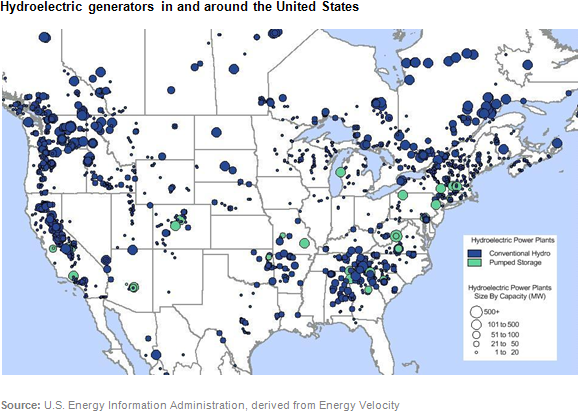
Hydroelectric power resources form regional clusters

Hydroelectric power generation resources are spread unevenly across North America. Some regions, like the Pacific Northwest, generate a significant amount of their electricity from hydro, while others have only limited hydro resources available.
Between 6-9% of U.S. electric generation was produced by hydropower between 1998 and 2009, depending on water availability. The size of hydroelectric power generators also varies; in fact, the largest plant in the United States is the hydroelectric plant at the Grand Coulee Dam in Washington, with a capacity of 7,079 MW. Although they are not pictured above, Alaska and Hawaii both have a small amount of hydro.
The inventory of U.S. hydroelectric generating plants consists mainly of three types of plants. Some conventional hydroelectric generators are incorporated into dammed reservoirs, providing them with a relatively reliable supply of water. Other conventional hydro plants are run-of-river, meaning they have no reservoir and their generating output is subject to changes in river flows. Unlike conventional hydro, pumped storage plants can function as energy storage. They have the ability to reverse their turbines, using power from the grid to force water into a reservoir, storing it there to generate electricity at a later time.
A large portion of the power imported to the United States from Canada is also generated from hydro. In the East, hydro power from Quebec and Ontario is particularly important in serving Northeastern U.S. markets. In the Midwest, a transmission line delivers hydropower from Manitoba to the United States, with minimal contact with the rest of the Canadian grid along the way. In the Pacific Northwest, the Columbia and Snake River Basins are geological and topological units with abundant water availability and river flows on both sides of the border. The preponderance of hydroelectric capacity on the U.S. side of the border tends to limit the benefits of hydropower trade in that region.
Tags: electricity, hydroelectric, map, renewables